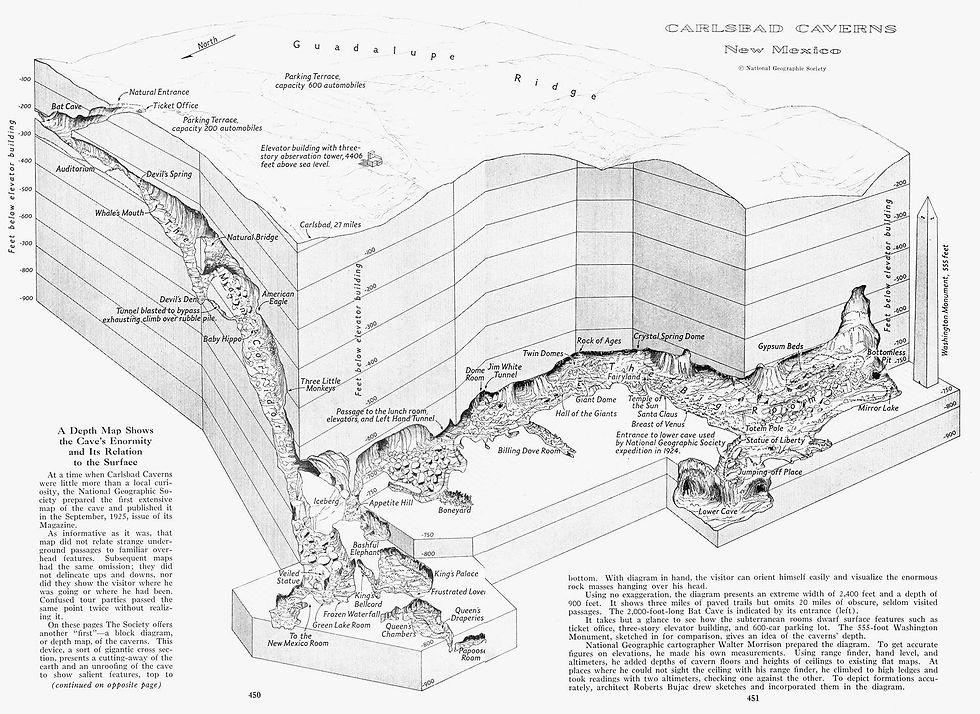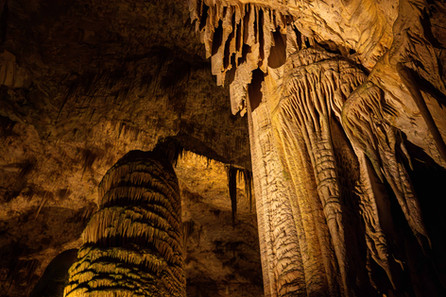Exploring the Depths: A Casual Stroll Through Carlsbad Caverns
- Anna Sharp
- May 20
- 4 min read
Introduction
I first visited Carlsbad Caverns in June of 2005 when my grandmother, affectionately called "Ma'am" by my family, took me, my sister, and my cousin Meghan on a two-week National Park tour as a high school graduation present. Even at 17, I was blown away by the stone formations, massive chambers, and utter darkness that slowly envelops you as you step deeper into this unique wonder of geological history.

Getting There
Reaching Carlsbad Caverns National Park is relatively straightforward. We stayed at the "Sunset Reef Campground," which is about a 20-minute drive from the cave entrance. If you're traveling with a small camper, the Visitor Center offers limited RV parking, and there were available spots on the day we visited. We were quite fortunate to arrive at Carlsbad the week before Christmas, as we nearly had the cavern to ourselves, aside from a few other couples or small groups. This wasn't the case the following week; Ben's sister and her family visited during Christmas week and couldn't make a reservation initially because they had already reached the maximum number of cave entries for that day...which leads us to our next tips.
Make a Reservation
To enter the cave, timed entry tickets are required. However, if you possess an America the Beautiful Pass, you can secure a reservation for a self-guided tour at no cost. During our visit on a relatively quiet day, we were able to stop by the Visitor Center and purchase our timed entry tickets on the spot. If you prefer to guarantee your entrance, we recommend making a reservation in advance.
Arrive Before 2 PM
To ensure that all visitors have ample time to explore the unique caverns and to guarantee that everyone exits Carlsbad by 5 PM, please note that the latest entry time for the cave is 2:30 PM.
The Natural Entrance
The Natural Entrance trail is a steep 1.25-mile (2 km) descent that goes down 750 feet (229 m) into the cavern. To put that into perspective, it's like walking down a 75-story building and takes on average an hour to complete.


First Impressions Inside

Overall Atmosphere
Inside the caverns, the atmosphere is charged with an eerie silence that amplifies the sense of isolation. The darkness is profound; as you hike further from the entrance, the light fades to a near-complete blackness. Your eyes strain to adjust, and for a moment, it feels as if you are nearly blind. The handrail becomes a lifeline, guiding you through the shadowy expanse. The stillness, combined with the occasional echo of dripping water, creates a meditative environment, inviting reflection and awe at the natural wonders surrounding you. In this subterranean world, time seems to stand still, and the beauty of nature unfolds in quiet majesty, leaving a lasting impression on all who dare to explore its depths.
Interesting Facts and History
Carlsbad Caverns National Park features a geological history of millions of years, formed by the dissolution of limestone through acidic groundwater. During the Permian Period, around 250–280 million years ago, the area was a shallow sea. Over time the sea evaporated, sediment buried the reef, which was later uplifted by tectonic activity, leading to the Guadalupe Mountains. Erosion eventually exposed the reef and created the caverns.

According to historical records, Native Americans, particularly the Mescalero Apache tribe, were well aware of Carlsbad Caverns and considered the cave a sacred site, utilizing the area around it for thousands of years, leaving behind rock art and evidence of their presence in the form of pictographs near the entrance; however, there's no substantial proof they explored deep into the cavern itself.
In 1898, a 16 year old cowboy name Jim White, re-discovered the cave entrance, and began offering tours. The 1880s also saw local settlers mining bat guano within the caves, which was a popular fertilizer at the time. Fun fact, the practice of using bat guano was discontinued due to it's high concentration of nitrates and their tendency to combust in transit...like dynamite.

In 1923, government official, Robert Holley, conducted a thorough mapping of the cave and advocated for its designation as a national monument. Following his recommendations, President Calvin Coolidge officially established Carlsbad Cave National Monument later that same year. The following year, in 1924, members of a National Geographic expedition explored the Lower Cave and documented their findings, further highlighting the cave's significance.
Modern Time Discoveries
In 2013, a remarkable room known as Halloween Hall was discovered, containing thousands of bat bones, and stunning crystal formations. Following this, in 2018, a team of women uncovered the Lake of Muddy Misery, which is recognized as the second-deepest known part of the cave.
Conclusion
Exploring Carlsbad Caverns is a truly awe-inspiring experience that leaves a lasting impression. The complex formations and expansive underground chambers evoke wonder about the natural world. The immense beauty and scale of these caverns remind us of nature's power and the importance of preserving such remarkable landscapes. I encourage fellow travelers to make Carlsbad Caverns a priority on their itineraries, as visiting these natural wonders not only offers stunning views but also fosters a deep appreciation for Earth's geological history and the delicate ecosystems thriving within its depths. Your visit can play a crucial role in ensuring that these extraordinary sites continue to be cherished for generations to come.















Comments